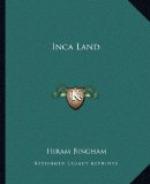The Urubamba River is known by various names to the people who live on its banks. The upper portion is sometimes spoken of as the Vilcanota, a term which applies to a lake as well as to the snow-covered peaks of the cordillera in this vicinity. The lower portion was called by the Incas the Uilca or the Uilcamayu.
Near the water-parting of La Raya I noticed the remains of an interesting wall which may have served centuries ago to divide the Incas of Cuzco from the Collas or warlike tribes of the Titicaca Basin. In places the wall has been kept in repair by the owners of grazing lands, but most of it can be but dimly traced across the valley and up the neighboring slopes to the cliffs of the Cordillera Vilcanota. It was built of rough stones. Near the historic wall are the ruins of ancient houses, possibly once occupied by an Inca garrison. I observed no ashlars among the ruins nor any evidence of careful masonry. It seems to me likely that it was a hastily thrown-up fortification serving for a single military campaign, rather than any permanent affair like the Roman wall of North Britain or the Great Wall of China. We know from tradition that war was frequently waged between the peoples of the Titicaca Basin and those of the Urubamba and Cuzco valleys. It is possible that this is a relic of one of those wars.
On the other hand, it may be much older than the Incas. Montesinos, [3] one of the best early historians, tells us of Titu Yupanqui, Pachacuti VI, sixty-second of the Peruvian Amautas, rulers who long preceded the Incas. Against Pachacuti VI there came (about 800 A.D.) large hordes of fierce soldiers from the south and east, laying waste fields and capturing cities and towns; evidently barbarian migrations which appear to have continued for some time. During these wars the ancient civilization, which had been built up with so much care and difficulty during the preceding twenty centuries, was seriously threatened. Pachacuti VI, more religious than warlike, ruler of a people whose great achievements had been agricultural rather than military, was frightened by his soothsayers and priests; they told him of many bad omens. Instead of inducing him to follow a policy of military preparedness, he was urged to make sacrifices to the deities. Nevertheless he ordered his captains to fortify the strategic points and make preparations




